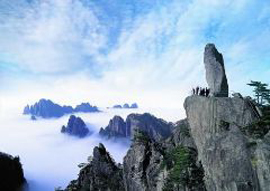Known as "the loveliest mountain of China", Mt. Huangshan was acclaimed through art and literature  during a good part of Chinese history. Today it holds the same fascination for visitors, poets, painters and photographers, who come in pilgrimage to this enchanting site. Famous for its four magnificent features: Oddly shaped pines, grotesque rock formations, sea of clouds and hot springs, the scenic area occupies 154 square kilometers and reaches an altitude of over 1800 meters. Once known as Mt. Yishan, this is where Emperor Xuanyuan is said to have prepared herbal medicines several thousand years ago. The mountain was renamed Huangshan in 747, the sixth year of Emperor Tianbao of the Tang Dynasty (618-907). during a good part of Chinese history. Today it holds the same fascination for visitors, poets, painters and photographers, who come in pilgrimage to this enchanting site. Famous for its four magnificent features: Oddly shaped pines, grotesque rock formations, sea of clouds and hot springs, the scenic area occupies 154 square kilometers and reaches an altitude of over 1800 meters. Once known as Mt. Yishan, this is where Emperor Xuanyuan is said to have prepared herbal medicines several thousand years ago. The mountain was renamed Huangshan in 747, the sixth year of Emperor Tianbao of the Tang Dynasty (618-907).
Vertical slabs of granite, eroded and fractured over thousands of years, have created soaring pillars of rock and deep ravines. Swirling mists constantly envelop and then reveal the jagged rock faces. The native pine on the mount (the pinus huangshanensis) makes its home in tiny crevices in the rock, with roots several times longer than its trunk, its top flattened by wind and its branches growing in one direction (with the wind or towards the sun). Therefore, Chinese people regard it as a symbol of determination and persistence.
In 1985, the mountain was elected one of China's Top Ten Scenic Spots. In 1990, Mt. Huangshan was listed as a "World Cultural and Natural Heritage" by UNESCO. In 2002, Mt. Huangshan established the sister-mountain relationship with Mt. Jungfraujoch, another world heritage site located in Switzerland.
Huangshan Attractions:
Hongcun and Xidi Village
Huashan Mysterious Grottos
Mount Huangshan
Tangyue Archways
Tunxi Old Street |
